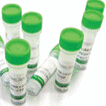
FITC anti-human CD3
货 号:300406
产品规格:100 tests
原 产 地:USA
参考价格:1235 (参考价格,以实际价格为准)
优惠价格:
300406 FITC anti-human CD3 100 tests
| Clone | UCHT1 |
| Isotype | Mouse IgG1, κ |
| Reactivity | Human, Cross-Reactivity: Chimpanzee |
| Formulation | Phosphate-buffered solution, pH 7.2, containing 0.09% sodium azide and 0.2% (w/v) BSA (origin USA). |
| Preparation | The antibody was purified by affinity chromatography, and conjugated with FITC under optimal conditions. The solution is free of unconjugated FITC. |
| Recommended Usage |
Each lot of this antibody is quality control tested by immunofluorescent staining with flow cytometric analysis. Test size products are transitioning from 20 µl to 5 µl per test. Please check your vial or your CoA to find the suggested use of this reagent per million cells in 100 µl staining volume or per 100 µl of whole blood. It is recommended that the reagent be titrated for optimal performance for each application. ” |
| Applications |
FC – Quality tested |
| Application Notes |
Additional reported applications (for the relevant formats) include: immunohistochemical staining of acetone-fixed frozen sections4,6,7 and formalin-fixed paraffin-embedded sections11, immunoprecipitation1, activation of T cells2,3,5, and Western blotting9. The LEAF™ purified antibody (Endotoxin <0.1 EU/μg, Azide-Free, 0.2 μm filtered) is recommended for functional assays (Cat. No. 300414). For highly sensitive assays, we recommend Ultra-LEAF™ purified antibody (Cat. No. 300438) with a lower endotoxin limit than standard LEAF™ purified antibodies (Endotoxin <0.01 EU/µg). |
| Application References |
1. Salmeron A, et al. 1991. J. Immunol. 147:3047. (IP) ” |
| Description |
CD3ε is a 20 kD chain of the CD3/T-cell receptor (TCR) complex which is composed of two CD3ε, one CD3γ, one CD3δ, one CD3ζ (CD247), and a T-cell receptor (α/β or γ/δ) heterodimer. It is found on all mature T lymphocytes, NK-T cells, and some thymocytes. CD3, also known as T3, is a member of the immunoglobulin superfamily that plays a role in antigen recognition, signal transduction, and T cell activation. |
| Storage | The antibody solution should be stored undiluted at 4°C and protected from prolonged exposure to light. Do not freeze. |
产品详细信息
300406 FITC anti-human CD3 100 tests
| Clone | UCHT1 |
| Isotype | Mouse IgG1, κ |
| Reactivity | Human, Cross-Reactivity: Chimpanzee |
| Formulation | Phosphate-buffered solution, pH 7.2, containing 0.09% sodium azide and 0.2% (w/v) BSA (origin USA). |
| Preparation | The antibody was purified by affinity chromatography, and conjugated with FITC under optimal conditions. The solution is free of unconjugated FITC. |
| Recommended Usage |
Each lot of this antibody is quality control tested by immunofluorescent staining with flow cytometric analysis. Test size products are transitioning from 20 µl to 5 µl per test. Please check your vial or your CoA to find the suggested use of this reagent per million cells in 100 µl staining volume or per 100 µl of whole blood. It is recommended that the reagent be titrated for optimal performance for each application. ” |
| Applications |
FC – Quality tested |
| Application Notes |
Additional reported applications (for the relevant formats) include: immunohistochemical staining of acetone-fixed frozen sections4,6,7 and formalin-fixed paraffin-embedded sections11, immunoprecipitation1, activation of T cells2,3,5, and Western blotting9. The LEAF™ purified antibody (Endotoxin <0.1 EU/μg, Azide-Free, 0.2 μm filtered) is recommended for functional assays (Cat. No. 300414). For highly sensitive assays, we recommend Ultra-LEAF™ purified antibody (Cat. No. 300438) with a lower endotoxin limit than standard LEAF™ purified antibodies (Endotoxin <0.01 EU/µg). |
| Application References |
1. Salmeron A, et al. 1991. J. Immunol. 147:3047. (IP) ” |
| Description |
CD3ε is a 20 kD chain of the CD3/T-cell receptor (TCR) complex which is composed of two CD3ε, one CD3γ, one CD3δ, one CD3ζ (CD247), and a T-cell receptor (α/β or γ/δ) heterodimer. It is found on all mature T lymphocytes, NK-T cells, and some thymocytes. CD3, also known as T3, is a member of the immunoglobulin superfamily that plays a role in antigen recognition, signal transduction, and T cell activation. |
| Storage | The antibody solution should be stored undiluted at 4°C and protected from prolonged exposure to light. Do not freeze. |
